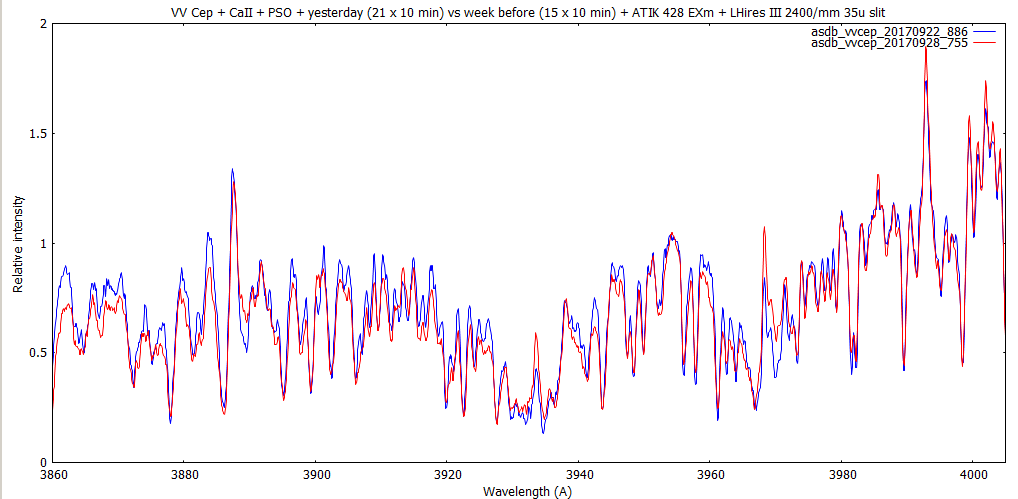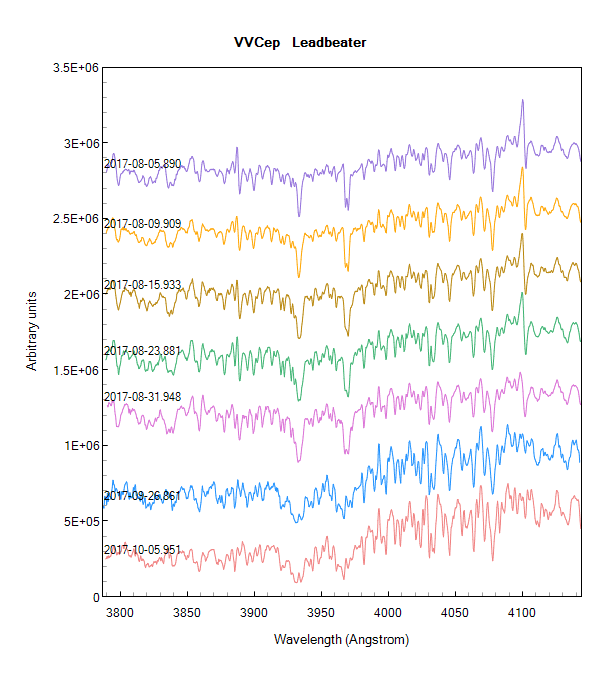Page 7 of 10
Re: VV Cep: Fe absorptions increase around Ca II doublet
Posted: Sat Sep 23, 2017 1:08 pm
by Robin Leadbeater
Hi Peter,
Unfortunately I do not have any data to fill the gap but comparing with my AZCas data, it seems that the ingress started ~ middle August as I suggested and is almost complete now. That would make the ingress period ~ >20 <30 days, compared with 6 days for AZCas. It depends on the geometry and orbital parameters of course but seems reasonable considering the relative periods of AZ Cas and VVCep.
Unfortunately B mag data in AAVSO is very sparse but the latest point 20170911 does show a drop compared with end August
Robin
Re: VV Cep: Fe absorptions increase around Ca II doublet
Posted: Sat Sep 23, 2017 3:42 pm
by Peter Somogyi
Hi Robin,
Thanks for the info, as for the aavso B serie I'd recommend selecting the latest low Bmag observation (017/09/11 as of now) and highlight that ovbserver code (nice feature from aavso!). You will find all those Bmags outstanding as low.
Of course, I'll re-observe this as soon as I can (indeed, I've been looking at the weather every day...), at least to see how stable this state is, or whether if there's any progress.
Now I would expect professionals could come up with something, they used to collect U mags (amateurs seemingly less willing to do), or any UV spectra from space.
Peter
Re: VV Cep: Fe absorptions increase around Ca II doublet
Posted: Sun Sep 24, 2017 9:22 am
by Ernst Pollmann
Peter,
from my spectroscopic observations in 1997 the ingress phase lasted 168 days.
From our current observations we found the first contact approx. at end of May. That means, the second contact would be to expect then approx. on November 14. With other words, we are still in the middle of ingress. This is confirmed among others with the ARAS Hα V/R monitoring (see attachment).
That means, in our visible spectral area the B component is not hidden trough “something else”. The spectra are still determind through both components. The undisturbed observable Hα V/R ratio, which reflects the precession period of the rotation axis of the accretion disk (absolutely new and surprising in our monitoring !!), confirmes that clearly.
Ernst
Re: VV Cep: Fe absorptions increase around Ca II doublet
Posted: Mon Sep 25, 2017 10:44 am
by Robin Leadbeater
Hi Ernst,
The inclination of the B star disc relative to the M star as seen near eclipse may not be the same from eclipse to eclipse. In the extreme, for example where the inclination of the disc was tangential to the M star edge at ingress the V/R ratio may not even change at all during ingress. The B star could even be fully eclipsed but both edges of the H alpha disc still visible. The B star photosphere is the only fixed point in this system.
Robin
Re: VV Cep: Fe absorptions increase around Ca II doublet
Posted: Mon Sep 25, 2017 2:42 pm
by Peter Somogyi
Analysing my result of 09.22 again, doublechecked validity and it's ok.
And, the earlier (till 09.09) the usual 1/5 ratio (found later better than 1/6) now on 09.22 this ratio is totally wrong, I am measuring now lika a 2:3 ratio (65.5% when rectifying to 3867.5:3870.1 and computing ratio of max[3999.5A +/- 0.2A] peak). However, subtraction result is not nice anymore. Division works a bit nicer.
What am I suspecting, the B component is partially (roughly like a 50%) glowing through a deeper layer (containing CaII) of the M component, and B is fully behind the outer layers (hence double EWs of the FeI lines). Must be quite complex to analyse, I am not getting any consumable result via subtraction anymore (since the previous at 09.09 that was still OK, ratio 1:5 worked).
That means it's yet not a total eclipse, but the deeper layer reached the B comp.
I highly recommend taking a daily Umag serie these days, using its curve drop (barycenter of a really short interval!) used to be the classic way to define the "eclipse" start (again, now I can imagine we are only seeing through a deeper layer partially + external layer fully, so that it's not a solid obstruction).
As for the H-alpha R/V graph, till those periodic variations not subtracted reliably (O-C ?), having those variations on top I can't read anything off from that graph even when I'd believe in its accuracy (something only a professional could tell us about).
- Peter
Re: VV Cep: Fe absorptions increase around Ca II doublet
Posted: Tue Sep 26, 2017 2:13 pm
by Ernst Pollmann
Peter,
you wrote:
As for the H-alpha R/V graph, till those periodic variations not subtracted reliably (O-C ?), having those variations on top I can't read anything off from that graph even when I'd believe in its accuracy (something only a professional could tell us about).
The so-called violett-to-red ratio V/R does have its roots in the basic research of Be stars during 1991-98, mainly performed by R. W. Hanuschik and A. T. Okazaki. In order to understand what V/R really means, I highly recommend the study of following literature:
1. Astronomical Spectrography for Amateurs
by J. P. Rozelot & C. Neiner; ISBN: 978-2-7598-0629-4
Capter: Spectroscopy of Be stars, by C. Neiner
2. Long-term V/R variations of Be stars
by A. T. Okazaki; Publ. Astron. Soc. Japan, 43, 1991
3. On the structure of Be stars
by R. W. Hanuschik; A&A, 308, 1996
Without understanding the nature of the parameter V/R it will be very hard, to appreciate and use the high content of information in some cases.
Hope, the study of this literature helps.
Best wishes,
Ernst
Re: VV Cep: Fe absorptions increase around Ca II doublet
Posted: Wed Sep 27, 2017 5:19 pm
by Robin Leadbeater
Attached are a series of spectra of VV Cep covering 3800-4150A at R ~2500 (variable 3000-1500 across the range due to LHIRES chromatism)
Note the loss of H Balmer emission, broadening of the Ca II H K lines and relative drop in continuum flux below ~4000A, particularly noticeable in the latest spectrum recorded 2017-09-26
Robin
Re: VV Cep: Fe absorptions increase around Ca II doublet
Posted: Thu Sep 28, 2017 11:54 am
by Peter Somogyi
Thank you Robin for the confirmation, it is really a start of a classical eclipse, in shortly speaking.
We can still argue how much partial and accurate date of a total eclipse start (if it will ever be total...), but it has certainly begun in the past 1-2 weeks.
I'm shooting it very soon again, with assessing the B light ratio - haven't seen yet any proof that it's had fully vanished by now.
It would be nice to have a professional to confirm and/or elaborate the state which phase we are at exactly.
- Peter
Re: VV Cep: Fe absorptions increase around Ca II doublet
Posted: Fri Sep 29, 2017 2:39 pm
by Peter Somogyi
Fresh result from yesterday:

- vvcep_pso_20170928vs22_cmp.png (69.67 KiB) Viewed 12459 times
No relevant change since last week's surpise, some ref. star problem during the 3.5 hours might have caused a global continum shift.
H6 and H5 (H5 is almost together with CaII, as usual) along with the CaII central emissions are visible at this resolution, their origin is probably from the surrounding nebula, basically these features must be known.
- Peter
Re: VV Cep: Fe absorptions increase around Ca II doublet
Posted: Fri Oct 06, 2017 10:39 pm
by Robin Leadbeater
Attached is an updated series including my latest observation 2017-10-05. There has been no significant further change in the past 9 days. The ingress phase now appears to be complete at this wavelength.
Robin

- vvcep_20170805-20171005_Leadbeater.png (90.5 KiB) Viewed 12390 times